Sorghum (Sorghum bicolor)
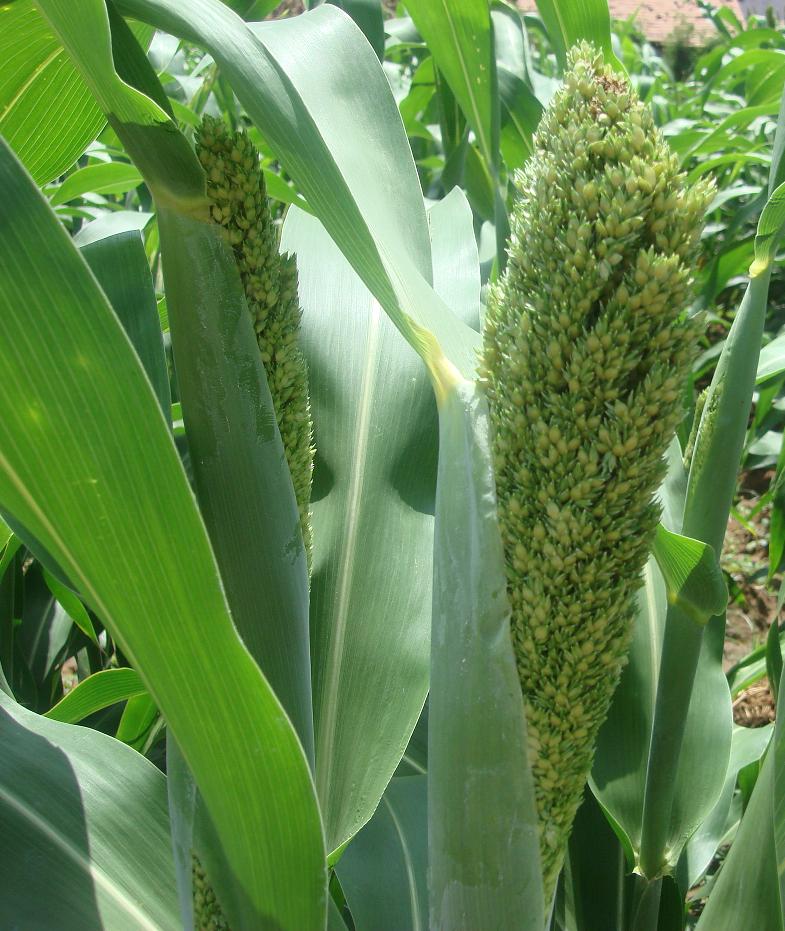
I. SEASON AND VARIETIES
| District/Season |
Month |
Varieties/Hybrids |
| 1. Tiruchirapalli |
| Thaipattam |
Jan. – Feb. |
TNAU SORGHUM HYBRID CO 5, BSR 1 |
| Chithiraipattam |
April - May |
BSR 1, TNAU SORGHUM HYBRID CO 5 |
| Adipattam |
June - July |
K Tall, CO (S) 28, TNAU SORGHUM variety CO 30, BSR 1 |
| Puratasipattam |
Sept. – Oct. |
K Tall, CO (S) 28, TNAU SORGHUM variety CO 30, BSR 1 |
| 2. Kanchipuram/Tiruvallur |
| Thaipattam |
January - February |
CO (S) 28, TNAU SORGHUM variety CO 30, BSR 1, TNAU SORGHUM HYBRID CO 5 |
| Chithiraipattam |
April - May |
CO (S) 28, TNAU SORGHUM variety CO 30, BSR 1, TNAU SORGHUM HYBRID CO 5 |
| Adipattam |
June - July |
K Tall, CO (S) 28, TNAU SORGHUM variety CO 30, BSR 1, TNAU SORGHUM HYBRID CO 5, |
| Puratasipattam |
Sept.- Oct. |
K Tall, CO (S) 28, TNAU SORGHUM variety CO 30, BSR 1 |
| 3. Vellore/Tiruvannamalai |
| Thaipattam |
January - February |
CO (S) 28, TNAU SORGHUM variety CO 30, TNAU SORGHUM HYBRID CO 5, BSR 1 |
| Chithiraipattam |
April - May |
CO (S) 28, TNAU SORGHUM variety CO 30, TNAU SORGHUM HYBRID CO 5, BSR 1 |
| Adipattam |
June - July |
K Tall, CO (S) 28, TNAU SORGHUM variety CO 30, BSR 1, TNAU SORGHUM HYBRID CO 5, Paiyur 1 |
| Puratasipattam |
September - October |
K Tall, CO (S) 28, TNAU SORGHUM variety CO 30, BSR 1, Paiyur 2 |
| 4. Cuddalore/ Villupuram |
| Thaipattam |
January - February |
CO (S) 28, TNAU SORGHUM variety CO 30, TNAU SORGHUM HYBRID CO 5, BSR 1 |
| Chithiraipattam |
April - May |
CO (S) 28, TNAU SORGHUM variety CO 30, TNAU SORGHUM HYBRID CO 5, BSR 1 |
| Adipattam |
June - July |
K Tall, CO (S) 28, TNAU SORGHUM variety CO 30, BSR 1, TNAU SORGHUM HYBRID CO 5 |
| Puratasipattam |
September - October |
K Tall, CO(S) 28, TNAU SORGHUM variety CO 30, BSR 1 |
| 5. Coimbatore/Tirupur |
| Thaipattam |
January - February |
CO (S) 28, TNAU SORGHUM variety CO 30, TNAU SORGHUM HYBRID CO 5, BSR 1 |
| Chithiraipattam |
April - May |
CO (S) 28, TNAU SORGHUM variety CO 30, BSR 1, TNAU SORGHUM HYBID CO 5 |
| Adipattam |
June - July |
CO (S) 28, TNAU SORGHUM variety CO 30, BSR 1 |
| Puratasipattam |
Sept. – Oct. |
CO (S) 28, TNAU SORGHUM variety CO 30 |
| 6. Erode |
| Thaipattam |
January - February |
CO (S) 28, TNAU SORGHUM variety CO 30, TNAU SORGHUM HYBRID CO 5, BSR 1 |
| Chithiraipattam |
April - May |
CO (S) 28,TNAU SORGHUM variety CO 30, BSR 1, TNAU SORGHUM HYBRID CO 5 |
| Adipattam |
June - July |
CO (S) 28, TNAU SORGHUM variety CO 30, BSR 1, Paiyur 2 |
| Puratasipattam |
Sept.- Oct. |
CO (S) 28, TNAU SORGHUM variety CO 30, BSR 1, Paiyur 2 |
| 7. Karur/Perambalur/Ariyalur |
| Thaipattam |
Jan. – Feb. |
TNAU SORGHUM HYBRID CO 5, BSR 1 |
| Chithiraipattam |
April - May |
BSR 1, TNAU SORGHUM HYBRID CO 5 |
| Adipattam |
June - July |
K Tall, CO (S) 28, TNAU SORGHUM variety CO 30, BSR 1 |
| Puratasipattam |
Sept. – Oct. |
K Tall, CO (S) 28, TNAU SORGHUM variety CO 30, BSR 1 |
| 8. Salem/Namakkal |
| Thaipattam |
Jan.- Feb. |
CO (S) 28, TNAU SORGHUM variety CO 30, BSR 1 |
| Chithiraipattam |
April - May |
CO (S) 28, TNAU SORGHUM variety CO 30, BSR 1 |
| Adipattam |
June - July |
CO (S) 28, Paiyur 1, Paiyur 2, BSR 1 |
| Puratasipattam |
Sept. – Oct. |
CO (S) 28, TNAU SORGHUM variety CO 30, Paiyur 2, BSR 1 |
| 9. Dharmapuri/Krishnagiri |
| Thaipattam |
Jan. – Feb. |
CO (S) 28, TNAU SORGHUM variety CO 30, BSR 1 |
| Chithiraipattam |
April - May |
CO (S) 28, TNAU SORGHUM variety CO 30, BSR 1 |
| Adipattam |
June - July |
CO (S) 28, TNAU SORGHUM variety CO 30, Paiyur 1, Paiyur 2 |
| Puratasipattam |
Sept. – Oct. |
CO (S) 28, TNAU SORGHUM variety CO 30, Paiyur 2 |
| 10. Pudukottai |
| Thaipattam |
Jan. – Feb. |
BSR 1, TNAU SORGHUM HYBRID CO 5 |
| Chithiraipattam |
April - May |
BSR 1, TNAU SORGHUM HYBRID CO 5 |
| Adipattam |
June - July |
CO (S) 28, TNAU SORGHUM variety CO 30, K Tall, BSR 1, TNAU SORGHUM HYBRID CO 5 |
| Puratasipattam |
Sept. – Oct. |
CO (S) 28, TNAU SORGHUM variety CO 30, K Tall, BSR 1 |
| 11. Madurai/Dindigul/Theni |
| Thaipattam |
Jan. – Feb. |
CO (S) 28, TNAU SORGHUM variety CO 30, TNAU SORGHUM HYBRID CO 5, BSR 1 |
| Chithiraipattam |
April - May |
CO (S) 28, TNAU SORGHUM variety CO 30, BSR 1, TNAU SORGHUM HYBRID CO 5 |
| Adipattam |
June - July |
CO(S) 28, TNAU SORGHUM variety CO 30, K 11, BSR 1, TNAU SORGHUM HYBRID CO 5, APK 1 |
| Puratasipattam |
Sept. – Oct. |
CO(S) 28, TNAU SORGHUM variety CO 30, K Tall, K 11, BSR 1, APK 1 |
| 12. Ramanathapuram/ Virudhunagar/ Sivaganga |
| Thaipattam |
January - February |
CO (S) 28, TNAU SORGHUM variety CO 30, TNAU SORGHUM HYBRID CO 5 |
| Chithiraipattam |
April - May |
CO (S) 28,TNAU SORGHUM variety CO 30, BSR 1, TNAU SORGHUM HYBRID CO 5 |
| Adipattam |
June - July |
BSR 1, TNAU SORGHUM HYBRID CO 5, APK 1 |
| Puratasipattam |
Sept. – Oct. |
TNAU SORGHUM variety CO 30, K 11, K Tall, BSR 1, APK 1 |
| 13. Tirunelveli/ Thoothukudi |
| Thaipattam |
January - February |
CO (S) 28, TNAU SORGHUM variety CO 30, TNAU SORGHUM HYBRID CO 5, BSR 1 |
| Chithiraipattam |
April - May |
CO (S) 28, TNAU SORGHUM variety CO 30, TNAU SORGHUM HYBRID CO 5, BSR 1 |
| Adipattam |
June - July |
K Tall, K 11, CO(S) 28, TNAU SORGHUM variety CO 30, BSR 1, APK 1 |
| Puratasipattam |
September - October |
K Tall, CO (S) 28, TNAU SORGHUM variety CO 30, K 11, BSR 1, APK 1 |
| 14. Kanyakumari |
| Thaipattam |
Jan. – Feb. |
CO (S) 28, TNAU SORGHUM variety CO 30, TNAU SORGHUM HYBRID CO 5 |
| Chithiraipattam |
April - May |
CO (S) 28, TNAU SORGHUM variety CO 30, TNAU SORGHUM HYBRID CO 5 |
II. PARTICULARS OF SORGHUM VARIETIES
| PARTICULARS |
CO (S) 28 |
TNAU SORGHUM variety CO 30 |
TNAU SORGHUM HYBRID CO 5 |
| Parentage |
Derivative of CO 25 x SPV 942 |
Derivative of APK 1 x TNS 291 |
Derivative of ICS 51A x TNS 30 |
| Duration (days) |
100-105 |
95-105 |
95-105 |
| Area (Districts) |
All districts |
All districts |
All districts |
| Season (Pattam) |
| Rainfed |
Adi, Puratasi |
Adi, Puratasi |
Adi, Puratasi |
| Irrigated |
Thai, Chithirai |
Thai, Chithirai |
Thai, Chithirai |
| Grain yield kg/ha |
| Rainfed |
2493 |
2400 |
2770 |
| Irrigated |
4568 |
3360 |
4340 |
| Fodder yield kg/ha |
| Rainfed |
12600 |
7000 |
7560 |
| Irrigated |
17700 |
9200 |
10550 |
| Stalk |
Juicy |
Juicy |
Juicy |
| Height (cm) |
220-240 |
220-240 |
210-230 |
| Sheath colour |
Tan Green |
Tan Green |
Tan Node Green |
| Midrib |
Dull white |
Dull white |
Dull white |
| Earhead shape |
Cylindrical |
Cylindrical |
Cylindrical |
| Compactness |
Semi compact |
Semi compact |
Semi Loose Elliptical |
| Grain colour |
White |
White |
Pearly white |
| Special features |
Moderately resistant to shootfly, ear head bugs and grain mould |
Moderatly high dry Matter digestibility tolerance to shootfly, grainmould and downy mildew |
Moderatly high dry Matter digestibility tolerance to shootfly, grainmould |
| PARTICULARS |
CO 26 |
CO (S) 28 |
COH 4 |
| Parentage |
Derivative of |
Derivative of |
296A X TNS30 |
| |
MS 8271x IS 3691 |
CO 25 x SPV 942 |
|
| Duration (days) |
105 - 110 |
100-105 |
105 - 110 |
| Area (Districts) |
All districts |
All districts |
All districts |
| Season (Pattam) |
|
|
|
| Rainfed |
Adi, Puratasi |
Adi, Puratasi |
… |
| Irrigated |
Thai, Chithirai |
Thai, Chithirai |
Thai, Chithirai |
| Grain yield kg/ha |
|
|
|
| Rainfed |
4500 |
2493 |
... |
| Irrigated |
6000 |
4568 |
6500 |
| Fodder yield kg/ha |
|
|
|
| Rainfed |
14000 |
12600 |
... |
| Irrigated |
19000 |
17700 |
20000 |
| Stalk |
Juicy, Sweet |
Juice |
Juicy |
| Height (cm) |
160 - 190 |
220-240 |
200 - 215 |
| Sheath colour |
Green |
Tan |
Green |
| Node |
Green |
Green |
Green |
| Midrib |
Dull white |
Dull white |
White |
| Earhead shape |
Long cylindrical |
Cylindrical |
Elliptic |
| Compactness |
Semi compact |
Semi compact |
Semi Compact |
| Grain colour |
Pearly white |
White |
Pearly white |
| Special features |
-- |
-- |
Less incidence of leaf diseases, grain mould and sugary diseases |
| PARTICULARS |
PAIYUR 1 |
K Tall |
K 11 |
| Parentage |
CO 19 X CO 24 |
2219A x IS3541 |
K 7 x A 6552 |
| Duration (days) |
145 - 150 |
90 |
110-115 |
| Area (Districts) |
North east and north western districts |
Southern districts and other districts |
Southern districts |
| Season (Pattam) |
|
|
|
| Rainfed |
Adi, Puratasi |
Adi, Puratasi |
Puratasi |
| Irrigated |
... |
Thai, Chithirai |
… |
| Grain yield kg/ha |
|
|
|
| Rainfed |
1000 |
3750 |
1560 |
| Irrigated |
... |
4250 |
-- |
| Straw yield kg/ha |
|
|
|
| Rainfed |
9000 |
11250 |
10360 |
| Irrigated |
... |
13250 |
-- |
| Stalk |
Juicy |
Juicy |
Thin, Juicy and Sweet |
| Height (cm) |
300 |
254 |
220-260 |
| Sheath colour |
Green |
Brown |
Reddish purple at maturity |
| Node |
Green |
Green |
Green, glabrous |
| Midrib |
White |
Dull white |
Dull white |
| Earhead shape |
Lax panicle |
… |
Erect, loose panicle, |
| Compactness |
Open |
Lanceolate Semi open |
Semiopen |
| Grain colour |
Pearly white |
Cream pearly |
Red colour, partially covering the grain |
| Special features |
Tolerant to drought, non lodging, photosensitive |
-- |
Tolerant to drought Resistant to lodging, non shattering |
| Particulars |
BSR 1 |
Paiyur 2 |
APK 1 |
| Parentage |
(Multiple cross derivative |
Pureline selection |
Hybrid derivative of |
| |
(SC 108 - 3 x ICSV 4) |
from IS 15845 |
TNS 30 x CO 26 |
| |
16-3-1 x (MR-801 x |
|
|
| |
R 2751) 4-1-1 |
|
|
| Duration (days) |
105-110 |
90-95 |
105-110 |
| Area (Districts) |
Western Zone |
Salem, Namakkal |
Southern districts of |
| |
(Coimbatore, Erode, parts of Salem, Trichirappalli Perambalur, Karur and Dindigul) |
|
Tamil Nadu |
| Season (Pattam) |
|
|
|
| Rainfed |
Adi-puratasi |
Puratasi |
Adi, Puratasi |
| Irrigated |
Thai-Chitirai |
|
|
| Grain yield (Kg/ha) |
|
|
|
| Rainfed |
2500 - 3500 |
2113 |
2619 |
| Irrigated |
6000 – 6500 |
… |
… |
| Fodder Yield(kg/ha) |
|
|
| Rainfed |
8600 |
8789 |
8090 |
| Irrigated |
9600 |
… |
… |
| Stalk |
Juicy, sweet |
Juicy, sweet |
Pithy |
| Height (cm) |
150 – 180 |
200-215 |
175 |
| Sheath colour |
Reddish purple |
Green |
Tan |
| Node |
Green |
Green |
Green |
| Mid rib |
Dull white |
White |
Dull white |
| Earhead shape |
Long, cylindrical |
Elliptic |
Medium cylindrical |
| Compactness |
Semi-compact |
Semi-compact |
Semi-compact |
| Grain colour |
Pearly white |
Red |
White |
| Special features |
Fertilizer responsive, moderate resistance to earhead bug, shoot fly and stem borer. |
Dual purpose red grain sorghum suited to rainfed tract of Salem Namakkal districts. Tolerant to downy mildew and charcoal rot diseases. |
Non-lodging |
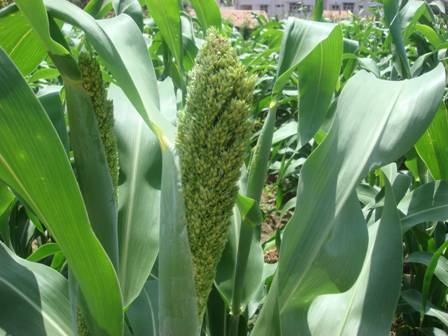
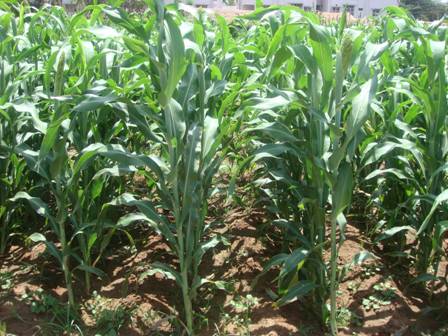 Growth stages of sorghum
1.
2.
3.
4.
5. |
Seedling stage
Vegetative stage (Grand growth (30-40)
Flowering/Reproductive Stage
Maturity
Ripening |
:
:
:
:
: |
1-15 days
16-40 days
41-65 days
66-95 days
96-105 days |
SELECTION OF SEEDS
Good quality seeds are collected from disease and pest-free fields.
Quantity of seed required
Irrigated Transplanted - 7.5 kg/ha; Direct sown - 10 kg/ha
Rainfed Direct sown - 15 kg/ha
Sorghum under irrigated condition is raised both as a direct sown and transplanted crop.
Transplanted crop has the following advantages:
- Main field duration is reduced by 10 days.
- Shoot fly, which attacks direct sown crops during the first 3 weeks and which is difficult to control, can be effectively and economically controlled in the nursery itself.
- Seedlings which show chlorotic and downy mildew symptoms can be eliminated, thereby incidence of downy mildew in the main field can be minimised.
- Optimum population can be maintained as only healthy seedlings are used for transplanting.
- Seed rate can also be reduced by 2.5 kg/ha.
Population
150 plants for 10 m2, leaving only one healthy plant per hill.
II. NURSERY PRACTICES
1. NURSERY PREPARATION
For raising seedlings to plant one hectare, select 7.5 cents (300 m2) near a water source where water will not stagnate.
2. APPLICATION OF FYM TO THE NURSERY
- Apply 750 kg of FYM or compost for 7.5 cents nursery and apply another 500 kg of compost or FYM for covering the seeds after sowing.
- Spread the manure evenly on the unploughed soil and incorporate by ploughing or apply just before last ploughing.
3. LAYING THE NURSERY
- Provide three separate units of size 2 m x 1.5 m with 30 cm space in between the plots and all around the unit for irrigation.
- Excavate the soil from the inter-space and all around to a depth of 15 cm to form channels and spread the soil removed on the bed and level.
4. PRE-TREATMENT OF SEEDS
- Treat the seeds 24 hours prior to sowing with Carbendazim or Captan or Thiram at 2g/kg of seed.
- Treat the seeds with three packets (600 g) / ha of Azospirillum and 3 packets (600g) of phosphobacteria or 6 packets of Azophos (1200g) using rice kanji as binder.
5. SOWING AND COVERING THE SEEDS
- Make shallow rills, not deeper than 1 cm on the bed by passing the fingers vertically over it.
- Broadcast 7.5 kg of treated seeds evenly on the beds.
- Cover by leveling the rills by passing the hand lightly over the soil.
6. WATER MANAGEMENT
- Provide one inlet to each nursery unit.
- Allow water to enter through the inlet and cover all the channels till the raised beds are wet and then cut off water and
- Adjust the frequency of irrigation according to the soil types as follows:
| Number of irrigations |
Red soils |
Heavy soils |
First irrigation |
Immediately after sowing |
Immediately after sowing |
Second irrigation |
3rd day after sowing |
4th day after sowing |
Third irrigation |
7th day after sowing |
9th day after sowing |
Fourth irrigation |
12th day after sowing |
16th day after sowing |
NOTE: Do not keep the seedlings in the nursery for more than 18 days. If older seedlings are used, establishment and yield are adversely affected. Do not allow cracks to develop in the nursery by properly adjusting the quantity of irrigation water.
III. MAIN FIELD PREPARATION FOR IRRIGATED CROP
1. PLOUGHING
Plough the field with an iron plough once (or) twice. Sorghum does not require fine tilth since it adversely affects germination and yield in the case of direct sown crop.
To overcome the subsoil hard pan in Alfisols (deep red soils) chiselling the field at 0.5 m intervals to a depth of 40 cm on both the directions of the field followed by disc ploughing once and cultivator ploughing twice help to increase the yield of sorghum and the succeeding blackgram also. This was true with Sorghum followed by Groundnut also.
Application of FYM and 100% of recommended N can also be followed. In soils with sub-soil hard pan, chiselling should be done every year at the start of the cropping sequence to create a favourable physical environment.
2. APPLICATION OF FYM
Spread 12.5 t/ha FYM or composted coir pith along with 10 packets of Azospirillum (2000g/ha) and 10 packets (2000 g/ha) of phosphobacteria or 20 packets of Azophos (4000g/ha) on the unploughed field and incorporate the manure in the soil. Apply well decomposed poultry manure @ 5 t/ha to improve the grain yield as well as physical properties of soils.
3. FORMATION OF RIDGES AND FURROWS
- Form ridges and furrows using a ridger at 6 m long and 45 cm apart
- Form irrigation channels across the furrows
Alternatively, form beds of size 10 m2 and 20 m2 depending on the availability of water.
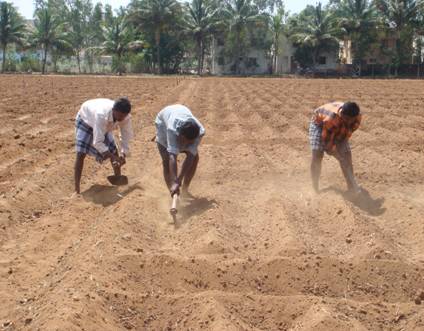 Forming ridges and furrows
Forming ridges and furrows
APPLICATION OF FERTILIZERS
Transplanted crop
- Apply NPK fertilizers as per soil test recommendations. If soil test recommendations are not available, adopt a blanket recommendation of 90 N, 45 P2O5, 45 K2O kg/ha.
- Apply N @ 50:25:25 % at 0, 15 and 30 DAS and full dose of P2O5 and K2O basally before planting
- In the case of ridge planted crop, open a furrow 5 cm deep on the side of the ridge at two thirds the distance from the top of the ridge and place the fertilizer mixture along the furrow and cover with soil upto 2 cm.
- Soil application of Azospirillum at 10 packets (2 kg/ha) and 10 packets (2000g/ha) of phosphobacteria or 20 packets of Azophos (4000g/ha) after mixing with 25 kg of FYM + 25 kg of soil may be carried out before sowing/planting.
Direct sown crop
- Apply NPK fertilizers as per soil test recommendations as far as possible. If soil test recommendations are not available, adopt a blanket recommendation of 90 N, 45 P2O5, 45 K2O kg/ha.
- Apply N @ 50:25:25 % at 0, 15 and 30 DAS and full dose of P2O and K2O5 basally before sowing and if basal application is not possible the same could be top dressed within 24 hours.
- In the case of bed planted crop, mark lines to a depth of 5 cm and 45 cm apart. Place the fertilizer mixture at the depth of 5 cm along the lines. Cover the lines upto 2 cm from the top before sowing.
- In the case of sorghum raised as a mixed crop with a pulse crop (Blackgram, Greengram or Cowpea) open furrows 30 cm apart to a depth of 5 cm.
- Apply fertilizer mixture in two lines in which sorghum is to be raised and cover upto 2 cm.
- Skip the third row in which the pulse crop is to be raised and place fertilizer mixture in the next two rows and cover upto 2 cm with soil.
- Application of bio-fertilizers: When Azospirillum is used apply only 75% of recommended N for irrigated sorghum.
- Soil test based fertilizer recommendation may be adopted in Western and North Western Zone viz., Alfisol, Inceptisol and Vertisol for prescribing fertilizer doses for specified yield targets.
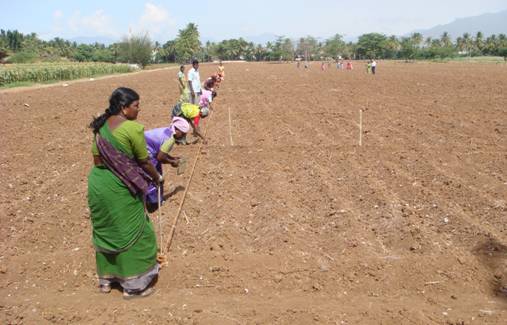 Sowing
Sowing5. APPLICATION OF MICRONUTRIENT MIXTURE
Transplanted Crop
- Mix 12.5 kg/ha of micronutrient mixture formulated by the Department of Agriculture, Tamil Nadu with enough sand to make a total quantity of 50 kg and apply the mixture over the furrows and on top one third of the ridges.
- If micronutrient mixture is not available, mix 25 kg of zinc sulphate with sand to make a total quantity of 50 kg and apply on the furrows and on the top one third of the ridges.
Direct Sown Crop
- Mix 12.5 kg of micronutrient mixture formulated by the Department of Agriculture, Tamil Nadu with enough sand to make a total quantity of 50 kg.
- Spread the mixture evenly on the beds.
- Basal application of 25 kg ZnSO4/ha-1 for the deficient soils or 12.5 kg Zn SO4 ha-1 + FYM for the Zn deficient soils.
- Basal application of FeSO4, 50 kg/ha along with 12.5 t/ha FYM for iron deficient soils.
IV. MANAGEMENT OF MAIN FIELD
Spacing: 45 x 15 cm
Population:15/m2
1. TRANSPLANTED CROP
- Pull out the seedlings when they are 15 to 18 days old.
- Prepare slurry with 5 packets of Azospirillum (1000g/ha) and 5 packets (1000g/ha) of Phosphobacteria or 10 packets of Azophos (2000 g/ha) in 40 lit. of water and dip the root portion of the seedlings in the solution for 15-30 minutes and transplant.
- Let in water through the furrows
- Plant one seedling per hill
- Plant the seedlings at a depth of 3 to 5 cm.
- Plant the seedlings on the side of the ridge, half the distance from the top of the ridge and the bottom.
- Maintain a spacing of 15 cm between plants in the row which are 45 cm apart (15/m2).
2. DIRECT SOWN CROP
- In the case of pure crop of sorghum, maintain the seed rate at 10kg/ha.
- In the case of inter crop of sorghum with pulse crop, maintain the seed rate of sorghum at 10 kg/ha and pulse crop at 10 kg/ha.
- In the case of pure crop of sorghum, sow the seeds with a spacing of 15 cm between seeds in the rows which are 45 cm apart.
- Maintain one plant per hill.
- If shootfly attack is there, remove the side shots and retain one healthy shoot.
- Sow the seeds over the lines where fertilizers are placed.
- Sow the seeds at a depth of 2 cm and cover with soil.
- In the case of sorghum intercropped with pulses sow one paired row of sorghum alternated with a single row of pulses. The spacing between the row of sorghum and pulse crop is 30 cm.
Forage cowpea CO 1 can be inter-cropped in sorghum at two rows of fodder cowpea in between paired rows of sorghum.
3. WEED MANAGEMENT
- Apply PE Atrazine @ 0.25 kg/ha on 3-5 DAS followed by 2,4-D @ 1 kg/ha on 20-25 DAS on the soil surface, using Backpack/Knapsack/Rocker sprayer fitted with a flat fan nozzle using 500 litres of water/ha (or) if herbicides are not used, hand weeding twice on 10-15 DAS and 30-35 DAS.
- Apply PE Atrazine@0.25 kg/ha on 3-5 DAS followed by one hand weeding on 30-35 DAS.
- In line sown crop, apply PE Atrazine @ 0.25 kg/ha on 3-5 DAS followed by Twin Wheel hoe weeder weeding on 30-35 DAS.
- In transplanted crop, apply PE Atrazine @ 0.25 kg/ha on 3-5 DAT followed by 2,4-D @ 1 kg/ha on 20-25 DAT.
- If pulse crop is to be raised as an intercrop in sorghum do not use Atrazine, spray PE Pendimethalin @ 0.75 kg/ha on 3-5 DAS
4. THINNING OF THE SEEDLINGS AND GAP FILLING
Direct sown crop
Thin the seedlings and gap fill with the seedlings thinned out. Maintain a spacing of 15 cm between plants after the first hand weeding on the 23rd day of sowing. Thin the pulse crop to a spacing of 10 cm between plants for all pulse crop except cowpea, for which spacing is maintained at 20 cm between plants.
5. DEFICIENCY SYMPTOMS
Zinc: Deficiency symptoms first appear in the newly formed leaves at 20 to 30 days age. Older leaves have yellow streaks or chlorotic striping between veins.
Iron:Interveinal chlorosis will be observed. If the deficiency continues the entire leaf including the veins may exhibit chlorotic symptoms. Newly formed leaves exhibit chlorotic symptoms. The entire crop may exhibit bleached appearance, dry and may die.
Direct sown crop
- Spray only if micronutrient mixture is not applied.
- Apply in case of iron deficiency.
- If soil is calcareous.
V. WATER MANAGEMENT
Regulate irrigation according to the following growth phase of the crop.
|
Transplanted crop |
Direct sown crop |
Growth phase |
1 to 40 days |
1 to 33 days |
Flowering phase |
41 to 70 days |
34 to 65 days |
Maturity phase |
71 to 95 days |
66 to 95 days |
| STAGES |
No. of Irrigation |
Days of Transplanting/Sowing of Crop |
| Transplanted |
Direct sown |
| Light soils |
|
| i. Irrigate for germination |
1 |
1st day |
1st day |
| or establishment |
2 |
4th day |
4th day |
| ii. Regulate irrigation |
1 |
15th day |
15th day |
| during vegetative phase |
2 |
28th day |
28th day |
| iii. Flowering phase (copious irrigation) |
1 |
40th day |
40th day |
| 2 |
52nd day |
52nd day |
| 3 |
.. |
64th day |
| iv. Maturity phase (Control irrigation) |
1 |
65th day |
76th day |
| 2 |
.. |
88th day |
| v. Stop irrigation thereafter |
.. |
.. |
|
| Heavy soils |
|
| i. Irrigate for germination or establishment |
1 |
1st day |
1st day |
| 2 |
4th day |
4th day |
| ii. Regulate irrigation during vegetative phase |
1 |
17th day |
17th day |
| 2 |
30th day |
30th day |
| iii. Flowering phase (give copious irrigation) |
1 |
40th day |
45th day |
| 2 |
52nd day |
60th day |
| 3 |
.. |
75th day |
| iv. Maturity phase (Control irrigation) |
1 |
72nd day |
90th day |
| v. Stop irrigation thereafter |
|
NOTE : Adjust irrigation schedule according to the weather conditions and depending upon the receipt of rains. Contingent Plan: This should be done before 75% of soil moisture is lost from available water. Spraying 3% Kaolin (30 g in one litre of water) during periods of stress will mitigate the ill effects.
V. HARVESTING AND PROCESSING |
i. |
Consider the average duration of the crop and observe the crop. When the crop matures the leaves turn yellow and present a dried up appearance. |
ii. |
The grains are hard and firm. |
iii. |
At this stage, harvest the crop by cutting the earheads separately. |
iv. |
Cut the straw after a week, allow it to dry and then stack. |
v. |
In the case of tall varieties, cut the stem at 10 to 15 cm above ground level and afterwards separate the earheads and stack the straw. |
vi. |
Dry the earheads. |
vii. |
Thresh using a mechanical thresher or by drawing a stone roller over the earheads or by using cattle and dry the produce and store. |
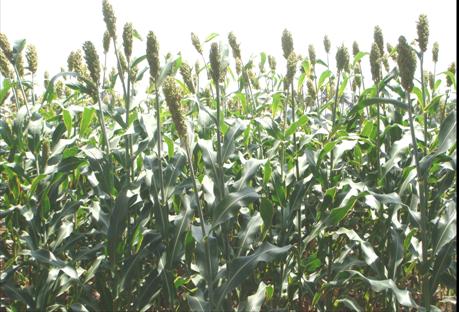
RAINFED SORGHUM
1. RAINFALL
Average and well distributed rainfall of 250-300 mm is optimum for rainfed sorghum.
2. DISTRIBUTION
Madurai, Dindigul, Theni, Ramanathapuram, Tirunelveli, Thoothukudi, Virudhunagar, Sivagangai, Tiruchirapalli, Erode, Salem, Namakkal, Coimbatore and Dharmapuri Districts.
3. SEASON
The crop can be grown in South West and North East monsoon seasons provided the rainfall is evenly distributed.
4. FIELD PREPARATION
Test the soil and apply fertilizers based on soil test recommendations.
- Field has to be prepared well in advance taking advantage of early showers.
- FYM application should be done @ 12.5 t / ha and well incorporated at the time of ploughing.
- Chiseling for soils with hard pan
- Chisel the soils having hard pan formation at shallow depths with chisel plough at 0.5 M interval, first in one direction and then in the direction perpendicular to the previous one once in three years. Apply 12.5 t FYM or composted Coir pith/ha besides chiseling to get an additional yield of about 30% over control.
- To conserve the soil moisture sow the seeds in flat beds and form furrows between crop rows during inter cultivation or during third week after sowing.
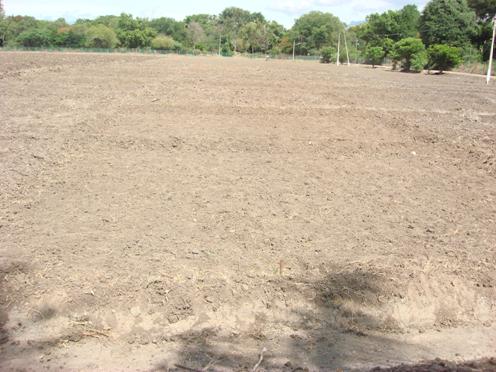 |
Sow the seeds in flat beds
 |
5. SEED RATE
15 kg/ha
6. SEED TREATMENT
Direct sown crop
Seed hardening ensures high germination. The seeds are pre-soaked in 2% potassium dihydrogen phosphate solution for 6 hours in equal volume and then dried back to its original moisture content is shade and are used for sowing.
- Harden the seeds with 1% aqueous fresh leaf extract of Prosopis juliflora and pungam, (Pongamia pinnata) mixed in 1:1 for 16 hrs at 1:0.6 ratio (Seed and solution) followed by drying and subsequently pelleting the seeds with Pungam leaf powder @300 g/kg with gruel.
- Halogenise the seeds containing CaOCl, CaCO3 and arappu leaf powder @ 5:4:1 ratio or iodine based (containing 2 mg of Iodine in 3 g of CaCO3) formulation @ 3g/kg packed in polylined cloth bag to maintain seed viability for more than 10 month.
- Soak the seeds in 2% (20 g in one litre of water) potassium dihydrogen phosphate or 500 ppm of CCC (500 mg in one litre of water) for six hours and shade dry the seeds for 5 hours. Use 350 ml of solution for soaking one kg of seed.
- Treat the seeds with three packets of azospirillum (600 g) and 3 packets of phosphobacteria or 6 packets of Azophos (1200 g/ha). In the main field, apply 10 packets of azospirillum 2000 g/ha and 10 packets (2000g/ha) of phosphobacteria or 20 packets of Azophos (4000 g/ha) with phosphobacteria 2 kg with 25 kg FYM + 25 kg soil.
- The seed is pelletised with 15 g of Chloropyriphos in 150 ml of gum and shade dried.
7. SOWING
Sow the seeds well before the onset of monsoon at 5 cm depth (by seed drill or by country plough). The seed is pelletised with 15 g of Chloropyriphos in 150 ml of gum and shade dried.
Pre-monsoon sowing
Sow the hardened seeds at 5 cm depth with seed cum fertilizer drill to ensure uniform depth of sowing and fertilizer application before the onset of monsoon as detailed below:
District |
Optimum period |
1. Coimbatore |
37-38th week (II to III week of September) |
2. Erode |
38th week (III week of September) |
3. Sivaganga |
40th week (I week of October) |
4. Ramanathapuram |
40th week (I week of October) |
5. Thoothukudi |
39-40th week (Last week of September to I week of October) |
6.Vellore, Tiruvannamalai |
37th-38th week (September II week to September III week) |
- Sow the sorghum seeds over the line where the fertilizers are placed.
- Sow the seeds at a depth of 5 cm and cover with the soil.
- Sow the seeds with the spacings of 15 cm in the paired rows spaced 60 cm apart.
- Sow the pulse seeds to fall 10 cm apart in the furrows between the paired rows of sorghum.
8. SPACING
45 x 15 cm or 45 x 10 cm.
9. FERTILIZER
Apply 12.5 t/ha of Composted Coir pith + NPK at 40:20:0; Apply enriched FYM 750 kg/ha. The recommended dose of 40 kg N and 20 kg P2O5/ha for rainfed sorghum can be halved if FYM @ 5 t/ ha is applied.
10. WEED MANAGEMENT
- Keep sorghum field free of weeds from second week after germination till 5th week. If sufficient moisture is available spray Atrazine 0.25 kg/ha as pre-emergence application within 3 days after the receipt of the soaking rainfall for sole sorghum and for sorghum based intercropping system with pulses, use Pendimethalin at 0.75 kg/ha.
- Under rainfed sorghum intercropped with cowpea as a pre- plant incorporation of isoproturba @ 0.5 kg ha-1 gave good control of weed with applied after 1st and 2nd spell of rainfall pendimethalin 1.0 kg ha-1 will be safer for both the crops.
11. CROPPING SYSTEM
-
The most profitable and remunerative sorghum based cropping system adopted is sorghum with cowpea, redgram, lab-lab, blackgram.
-
In rainfed Vertisol, adopt paired row planting in sorghum and sow one row of blackgram/ cowpea in between paired rows of sorghum to have 100% population of sorghum plus 33% population of blackgram/cowpea.
-
Intercropping of sunflower CO 1, with the main crop of sorghum CO 26 in 4:2 ratio is recommended under rainfed conditions during North-East monsoon for black soils of Coimbatore.
-
Intercropping of soybean with sorghum in the ratio 4:2 is recommended for kharif seasons.
-
For sorghum - blackgram intercropping system as well as sole cropping, application of 20 kg N and 20 kg P2O5/ha through enriched FYM and treating the seeds with Azospirillum is recommended for Aruppukottai region.
-
For sorghum (CO 25) + Fodder cowpea (CO 1) intercropping system, application of 20 kg N and 20 kg P2O5/ha with enriched FYM is recommended for Coimbatore region.
-
The intercropping system, fodder sorghum (K 7) + Fodder cowpea (CO 5) at 3:2 ratio is found profitable for rainfed Vertisols of Aruppukottai.
Tamarind and Neem trees upto 3-4 years from date of planting form an ideal tree component for agroforestry in black cotton soils of Kovilpatti. Sorghum and blackgram gave higher yield even at 50 per cent of the recommended level of fertilizer application
RATOON SORGHUM CROP
1. RATOONING TECHNIQUE
- Harvest the main crop leaving 15 cm stubbles.
- Remove the first formed two sprouts from the main crop and allow only the later formed two sprouts to grow. Allow two tillers per hill.
2. HOEING AND WEEDING
- Remove the weeds immediately after harvest of the main crop.
- Hoe and weed twice on 15th and 30th day after cutting.
3. APPLICATION OF FERTILIZERS
- Apply 100 kg N/ha in two split doses.
- Apply the first dose on 15th day after cutting and the second on 45th day after cutting.
- Apply 50 kg P2O5/ha along with the application of N on 45th day.
4. WATER MANAGEMENT
- Irrigate immediately after cutting the main crop.
- Irrigation should not be delayed for more than 24 hours after cutting.
- Irrigate on 3rd or 4th day after cutting.
- Subsequently irrigate once in 7 - 10 days.
- Stop irrigation on 70 - 80 days after ratooning.
5. HARVEST
Harvest the crop when the grains turn yellow.
NOTE: The duration of the ratoon crop is about 15 days less than the main crop.
6. CROP PROTECTION
7. POST HARVEST TECHNOLOGY
In India, sorghum grain is known as “jowar” and constitutes an important article of food after rice and wheat. The whole grain or the broken grain can be cooked like rice or the whole grain ground to flour and used to make chappaties. Sorghum grain is used as a source of starch in the fermentation industry for producing industrial alcohol and solvents. From a blend of wheat flour and sorghum flour, baked products like muffins, bread and cakes can be produced.
Click for more information
|







